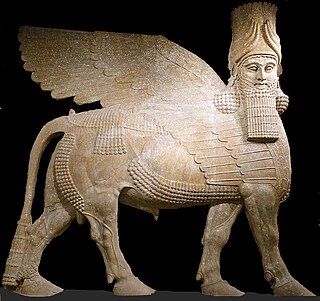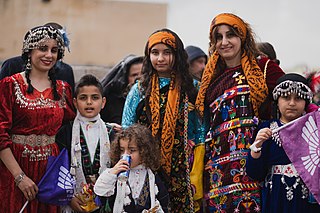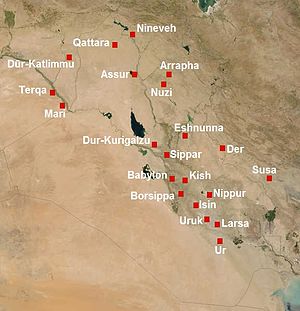
Assyria was a major ancient Mesopotamian civilization which existed as a city-state from the 21st century BC to the 14th century BC, which eventually expanded into an empire from the 14th century BC to the 7th century BC.

Iraq, a country located in West Asia, largely coincides with the ancient region of Mesopotamia, often referred to as the cradle of civilization. The history of Mesopotamia extends back to the Lower Paleolithic period, with significant developments continuing through the establishment of the Caliphate in the late 7th century AD, after which the region became known as Iraq. Within its borders lies the ancient land of Sumer, which emerged between 6000 and 5000 BC during the Neolithic Ubaid period. Sumer is recognized as the world’s earliest civilization, marking the beginning of urban development, written language, and monumental architecture. Iraq's territory also includes the heartlands of the Akkadian, Neo-Sumerian, Babylonian, Neo-Assyrian, and Neo-Babylonian empires, which dominated Mesopotamia and much of the Ancient Near East during the Bronze and Iron Ages.

Babylonia was an ancient Akkadian-speaking state and cultural area based in the city of Babylon in central-southern Mesopotamia. It emerged as an Akkadian populated but Amorite-ruled state c. 1894 BC. During the reign of Hammurabi and afterwards, Babylonia was retrospectively called "the country of Akkad", a deliberate archaism in reference to the previous glory of the Akkadian Empire. It was often involved in rivalry with the older ethno-linguistically related state of Assyria in the north of Mesopotamia and Elam to the east in Ancient Iran. Babylonia briefly became the major power in the region after Hammurabi created a short-lived empire, succeeding the earlier Akkadian Empire, Third Dynasty of Ur, and Old Assyrian Empire. The Babylonian Empire rapidly fell apart after the death of Hammurabi and reverted to a small kingdom centered around the city of Babylon.

The Hurrians were a people who inhabited the Ancient Near East during the Bronze Age. They spoke the Hurrian language, and lived throughout northern Syria, upper Mesopotamia and southeastern Anatolia.

Mitanni, earlier called Ḫabigalbat in old Babylonian texts, c. 1600 BC; Hanigalbat or Hani-Rabbat in Assyrian records, or Naharin in Egyptian texts, was a Hurrian-speaking state in northern Syria and southeast Anatolia with Indo-Aryan linguistic and political influences. Since no histories, royal annals or chronicles have yet been found in its excavated sites, knowledge about Mitanni is sparse compared to the other powers in the area, and dependent on what its neighbours commented in their texts.

Kirkuk is a city in Iraq, serving as the capital of the Kirkuk Governorate, located 238 kilometres north of Baghdad. The city is home to a diverse population of Kurds, Iraqi Turkmens and Arabs. Kirkuk sits on the ruins of the original Kirkuk Citadel which sits near the Khasa River.

Aššur (; Sumerian: 𒀭𒊹𒆠 AN.ŠAR2KI, Assyrian cuneiform: Aš-šurKI, "City of God Aššur"; Syriac: ܐܫܘܪ Āšūr; Old Persian: 𐎠𐎰𐎢𐎼 Aθur, Persian: آشور Āšūr; Hebrew: אַשּׁוּר ʾAššūr, Arabic: اشور), also known as Ashur and Qal'at Sherqat, was the capital of the Old Assyrian city-state (2025–1364 BC), the Middle Assyrian Empire (1363–912 BC), and for a time, of the Neo-Assyrian Empire (911–609 BC). The remains of the city lie on the western bank of the Tigris River, north of the confluence with its tributary, the Little Zab, in what is now Iraq, more precisely in the al-Shirqat District of the Saladin Governorate.

Aram was a historical region mentioned in early cuneiforms and in the Bible, populated by Arameans. The area did not develop into a larger empire but consisted of several small states in present-day Syria. Some of the states are mentioned in the Hebrew Bible, Aram-Damascus being the most outstanding one, which came to encompass most of Syria. In the Bible, Aram-Damascus is simply commonly referred to as Aram.

Lullubi,Lulubi, more commonly known as Lullu, were a group of Bronze Age tribes during the 3rd millennium BC, from a region known as Lulubum, now the Sharazor plain of the Zagros Mountains of modern-day Sulaymaniyah Governorate, Iraq. Lullubi was neighbour and sometimes ally with the Hurrian Simurrum kingdom. Frayne (1990) identified their city Lulubuna or Luluban with the region's modern town of Halabja.

The Civilization of Mesopotamia ranges from the earliest human occupation in the Paleolithic period up to Late antiquity. This history is pieced together from evidence retrieved from archaeological excavations and, after the introduction of writing in the late 4th millennium BC, an increasing amount of historical sources. While in the Paleolithic and early Neolithic periods only parts of Upper Mesopotamia were occupied, the southern alluvium was settled during the late Neolithic period. Mesopotamia has been home to many of the oldest major civilizations, entering history from the Early Bronze Age, for which reason it is often called a cradle of civilization.

The history of the Assyrians encompasses nearly five millennia, covering the history of the ancient Mesopotamian civilization of Assyria, including its territory, culture and people, as well as the later history of the Assyrian people after the fall of the Neo-Assyrian Empire in 609 BC. For purposes of historiography, ancient Assyrian history is often divided by modern researchers, based on political events and gradual changes in language, into the Early Assyrian, Old Assyrian, Middle Assyrian, Neo-Assyrian and post-imperial periods., Sassanid era Asoristan from 240 AD until 637 AD and the post Islamic Conquest period until the present day.

The Guti, also known by the derived exonyms Gutians or Guteans, were a people of the ancient Near East who both appeared and disappeared during the Bronze Age. Their homeland was known as Gutium.

The ancient Near East was home to many cradles of civilization, spanning Mesopotamia, Egypt, Iran, Anatolia and the Armenian highlands, the Levant, and the Arabian Peninsula. As such, the fields of ancient Near East studies and Near Eastern archaeology are one of the most prominent with regard to research in the realm of ancient history. Historically, the Near East denoted an area roughly encompassing the centre of West Asia, having been focused on the lands between Greece and Egypt in the west and Iran in the east. It therefore largely corresponds with the modern-day geopolitical concept of the Middle East.

Erbil, also called Hawler, is the capital and most populated city in the Kurdistan Region of Iraq. The city is in the Erbil Governorate.

Assyrian continuity is the study of continuity between the modern Assyrian people, a recognised Semitic indigenous ethnic, religious, and linguistic minority in Western Asia and the people of Ancient Mesopotamia in general and ancient Assyria in particular. Assyrian continuity and Mesopotamian heritage is a key part of the identity of the modern Assyrian people. No archaeological, genetic, linguistic, anthropological, or written historical evidence exists of the original Assyrian and Mesopotamian population being exterminated, removed, bred out, or replaced in the aftermath of the fall of the Assyrian Empire. Modern contemporary scholarship "almost unilaterally" supports Assyrian continuity, recognizing the modern Assyrians as the ethnic, linguistic, historical, and genetic descendants of the East Assyrian-speaking population of Bronze Age and Iron Age Assyria specifically, and Mesopotamia in general, which were composed of both the old native Assyrian population and of neighboring settlers in the Assyrian heartland.

The timeline of ancient Assyria can be broken down into three main eras: the Old Assyrian period, Middle Assyrian Empire, and Neo-Assyrian Empire. Modern scholars typically also recognize an Early period preceding the Old Assyrian period and a post-imperial period succeeding the Neo-Assyrian period.
The Early Assyrian period was the earliest stage of Assyrian history, preceding the Old Assyrian period and covering the history of the city of Assur, and its people and culture, prior to the foundation of Assyria as an independent city-state under Puzur-Ashur I c. 2025 BC. Very little material and textual evidence survives from this period. The earliest archaeological evidence at Assur dates to the Early Dynastic Period, c. 2600 BC, but the city may have been founded even earlier since the area had been inhabited for thousands of years prior and other nearby cities, such as Nineveh, are significantly older.
The post-imperial period was the final stage of ancient Assyrian history, covering the history of the Assyrian heartland from the fall of the Neo-Assyrian Empire in 609 BC to the final sack and destruction of Assur, Assyria's ancient religious capital, by the Sasanian Empire c. AD 240. There was no independent Assyrian state during this time, with Assur and other Assyrian cities instead falling under the control of the successive Median, Neo-Babylonian, Achaemenid, Seleucid and Parthian empires. The period was marked by the continuance of ancient Assyrian culture, traditions and religion, despite the lack of an Assyrian kingdom. The ancient Assyrian dialect of the Akkadian language went extinct however, completely replaced by Aramaic by the 5th century BC.
Lubdu, also written as Lubda or Lubdi, was a city in ancient Mesopotamia. It was a provincial center located south of Arrapḫa, modern Kirkuk.
















